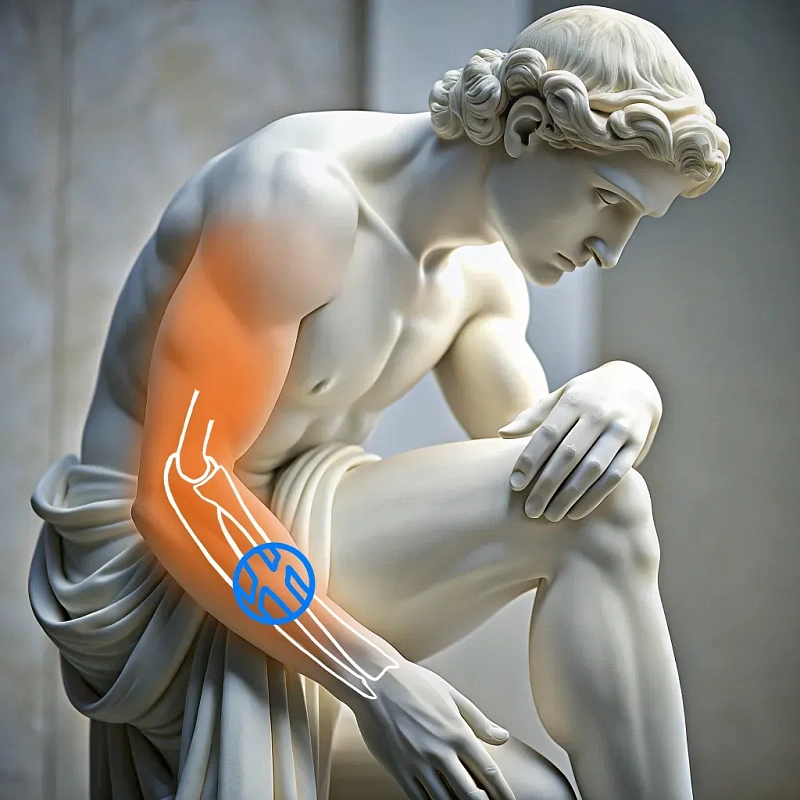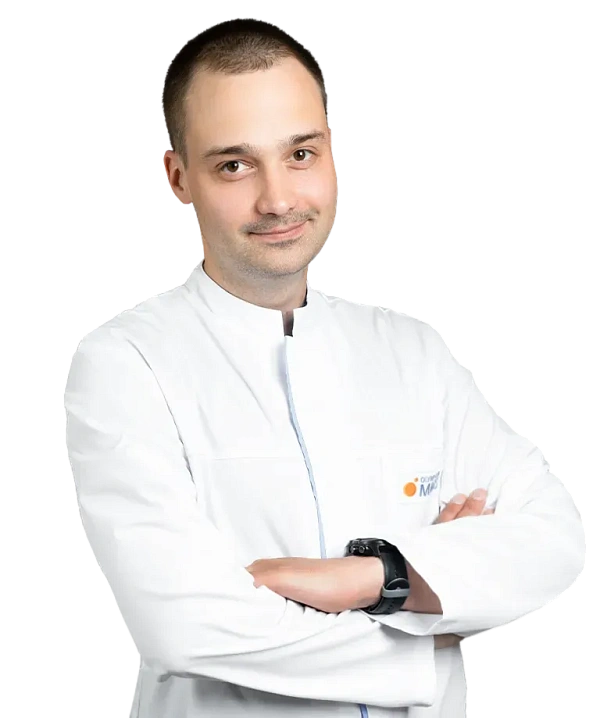Treatment of forearm fractures
A forearm bone fracture is one of the most common skeletal injuries, often caused by falls on an outstretched arm or from direct blows. Injuries can lead to severe pain, swelling, deformity and impaired arm function.

Forearm consists of two bones, the radius and the ulna, which provide movement and stability to the arm. The best treatment method is chosen based on the nature and extent of the fracture.
Complex cases, particularly displaced bone fragments, require surgical intervention - osteosynthesis. It enables bone fragments fixation by means of steel components, which promotes proper fusion and restoration of the forearm function. Osteosynthesis is performed using minimally invasive techniques, which reduces trauma and accelerates the recovery process. Patients can start rehabilitation the first few days after surgery under the supervision of a specialist.
Common blood and urine tests. Coagulogram ( blood clotting assessment). X-ray or computed tomography (CT) scan of the forearm Examination and consultation with a general practitioner for an overall assessment of the patient's health.
Treatment is based on the type and extent of the fracture. For simple, non-displaced fractures, the arm is immobilized with a plaster cast to ensure proper bone fusion. Surgery is required for displaced, complex fractures or in cases of threat to adjacent tissues. Surgery may include open reduction and internal fixation of the bone fragments with steel plates, screws and pins, as well as closed reduction with the use of steel rods to secure bone fragments.
X-ray equipment for intraoperative monitoring. Steel retainer set (plates, screws, pins) to secure bone fragments.
Rehabilitation starts after the treatment, to restore mobility, strength and arm function. The physician may prescribe physiotherapy, exercise therapy, and arm workout aimed at improving coordination and restoring motor functions. Duration and intensity of rehabilitation are based on the extent of the fracture and the patient's individual characteristics.
Benefits
Anatomy restoration
Securing and fusion of the bone fragments ensures proper placement and function of the arm.
Pain relief and mobility restoration
Patients will be able to return to regular activities, including completing everyday tasks and operating their arm.
Preventing complications
Prompt treatment prevents chronic pain, deformity and impaired arm function.
Frequently Asked Questions
What symptoms indicate a forearm fracture?
When does a forearm fracture require surgery?
How long does rehabilitation take after a forearm fracture?
Will I be able to move my forearm right after surgery?
Didn't find an answer to your question?
You can describe your problem in detail and ask a question to the doctor. He will answer you and help you find a solution
Specialists
Find a SpecialistCandidate of Medical Sciences. Orthopedic Trauma Surgeon. Head of the Traumatology Department.
Similar referral activities
Arthroscopy of the ankle joint
Ankle arthroscopy is a minimally invasive surgical procedure used to diagnose and treat various diseases and injuries of the ankle joint.
Arthroscopy of the ankle joint
Ankle arthroscopy is a minimally invasive surgical procedure used to diagnose and treat various diseases and injuries of the ankle joint.
Arthroscopy of the knee joint
Knee arthroscopy is a minimally invasive surgical procedure for the diagnosis and treatment of injuries and diseases of the knee joint. It allows examining the joint for damage and eliminating the identified defects.
Arthroscopy of the knee joint
Knee arthroscopy is a minimally invasive surgical procedure for the diagnosis and treatment of injuries and diseases of the knee joint. It allows examining the joint for damage and eliminating the identified defects.
Arthroscopy of the elbow joint
Arthroscopy of the elbow joint is a minimally invasive surgical intervention that allows for accurate diagnosis and simultaneous treatment of joint injuries.
Arthrodesis of the joints of the fingers of the hand
The destruction of the joints of the fingers of the hand is accompanied by pronounced pain and impaired functions. Arthrodesis is a surgical intervention in which the affected joint is completely immobilized, which relieves pain and progression of inflammation.
News & Media
All news and mediaHow to reach
How to get
From the Belorusskaya metro station of the Zamoskvoretskaya line - exit 4 After exiting the subway, walk through the pedestrian tunnel and climb the stairs. Move towards the railway tracks, go down the stairs immediately after them and walk along the house, then turn right onto 1st Yamskoye Pole Street. At the turn to 3rd Yamsky Pole Street, cross the road at the pedestrian crossing and continue along 1st Yamsky Field Street, after a few buildings on the left you will see Olympus Clinic MARS.
Travel time
9 minutes
Landmark
Olympus Clinic MARS sign
How to get
From the Belorusskaya metro station of the Ring line - exit 2. After exiting the subway, turn left and walk to the pedestrian crossing. Cross the road through two pedestrian crossings and move along the Tverskoy overpass. Go down the stairs immediately after the railway tracks, walk along the house, then turn right onto 1st Yamskoye Pole Street. At the turn to 3rd Yamsky Pole Street, cross the road at the pedestrian crossing and continue along 1st Yamsky Field Street, after a few buildings on the left you will see Olympus Clinic MARS
Travel time
11 minutes
Landmark
Olympus Clinic MARS sign
From the metro station "Tsvetnoy Bulvar"
1 exit to the city, then left to the Garden Ring, at the crossing to the right, crossing the boulevard, one more crossing and at the traffic light to the left. The Olymp Clinic building is located overlooking the Garden Ring to the right of the crossing. Travel time is approximately 9 minutes. Landmark - sign Olymp Clini
From the metro station "Sukharevskaya"
Exit 3 from the metro and 640 meters straight ahead, the clinic will be on the right. Landmark - sign Olymp Clinic
Parking lot map
Exit 3 from the metro and 640 meters straight ahead, the clinic will be on the right. Landmark - sign Olymp Clinic

From Sokol metro station
The last car from the center: follow the signs for Exit 5. From the glass doors to the right and go to the end of the passage. Exit to the city by the steps to the left. After exiting the crossing to the street, go straight along Leningradsky Prospekt to the intersection with Chapaevsky Lane. Next, turn right (onto Chapaevsky Lane) and walk to the Triumph Palace residential complex. Entrance to the territory: through checkpoint No. 1, opposite the Vkusville store, you will need to present your passport. After passing through the checkpoint, go up the stairs to the fountain, opposite it you will see our clinic.
Travel time
10-12 minutes
From the Airport metro station
The first car from the center: follow the Exit 2-3 signs. Turn left out of the glass doors and walk to the end of the passage. After exiting the crossing to the street, go straight along Leningradsky Prospekt to the intersection with Chapaevsky Lane. Next, turn left (onto Chapaevsky Lane) and walk to the Triumph Palace residential complex. Entrance to the territory: through checkpoint No. 1, opposite the Vkusville store, you will need to present your passport. After passing through the checkpoint, go up the stairs to the fountain, opposite it you will see our clinic.
Travel time
12-15 minutes
How to get
Entry to the territory is prohibited, but there are free city parking lots around the Triumph Palace residential complex, where you can easily find a place for your car. Free parking area:




